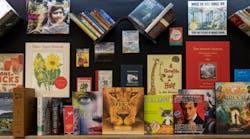When the Great Recession hit in 2008, 128-year-old Wisconsin printing company Worzalla was fresh off a walloping from overseas competition. Worzalla’s specialty was children’s books, and overnight almost 50% of that business migrated to China, which lured New York publishers with astronomically lower costs. Jim Fetherston, a veteran of printing monolith R.R Donnelly, came on the scene in 2011 as Worzalla’s new president and chief executive officer. Worzalla, “had been losing money for a while. They had a strong balance sheet, but it was clearly deteriorating. It was on a path to not surviving.”
Still, leading Worzalla, an employee-owned company which specialized in children’s picture books, was his dream job. Despite its financial struggles, the mid-sized printer had a stellar reputation in the marketplace. “Nobody ever said an ill word about Worzalla,” Fetherston recalls. When the headhunter called, he couldn’t believe the job had come open, but it had, he says, sounding like some part of him still can’t believe it.
Under Fetherston’s leadership, Worzalla not only turned around—its had its best year ever in 2018, beat that performance in 2019, and even with the coronavirus crisis is on track to beat that performance again in 2020. It’s in the midst of a three-year expansion that includes adding space, increasing the workforce and modernizing equipment.
The company is probably best known for publishing the bestselling “Diary of a Wimpy Kid” series. The last book in the series required a turnaround time of for weeks vs. the typical six, and the company learned a month before printing that the order would be twice as big and include more hardcover copies and fewer paperback copies. Fortunately, building speed to market was one of Fetherston’s priorities early on at the company, and they were up to the challenge.Jim Fetherston
As part of our new Profiles in Leadership series, Fetherston talked with IndustryWeek about business decisions he made to play to the company’s strengths and the competitive advantages for U.S. printing companies in the market today (Sneak preview: The Chinese government “editing” customers’ books has become an unexpected gift to U.S. publishers).
What were the challenges at Worzalla when you started as CEO in 2011?
The company was in tough shape. It had the one-two punch of economic recession and then just a few years before the recession, the American book manufacturing industry got hit hard by a movement to China—back in ’04, ’05. That really started to take an awful lot of volume that historically had been done domestically off to China, because China prices were astronomically low.
We were strictly a book manufacturer—at that time, mostly children’s picture books. And that’s’ exactly what China took from the U.S. market. So the company went through some rough years when I came in. They had been losing money for a while. They had a strong balance sheet, but it was clearly deteriorating. It was on a path to not surviving. So what we focused on in my early years was just to get the business financially on good ground. We were still kind of in shock—about 50% of the children’s book business went offshore, and almost 100% of that to China.
The other issue was that the printed book was going to go the way of the dodo bird and become extinct.
How did you begin tackling these problems?
We came up with a strategic plan with two principal drivers: What was going to stay in print, and what needed to be printed domestically—meaning short turnaround. We focused on that and grew those segments.
We went after movie tie-in books. We went after large, heavy books like cookbooks, lifestyle books; books that cost a whole lot more to transport. You could print them domestically and while it would cost you more from the production standpoint, it would be cheaper for transportation. And that would level the playing field a little bit with China. Not to mention that if you wanted to change content, you could do that very quickly with a domestic supplier and you also didn’t have to print as many books.
One of the secrets we discovered about the publisher’s side of the business, our customers’ side, is that not knowing how many books would sell, they frequently overbought. And then they had a lot of inventory at the end of the year. Domestically, we could do a very short run for them, and if the book was selling, we could go back to press into a reprint. Where in China you lose that flexibility because it takes so long to turn it around.
We focused on those characteristics and that worked out well. We even started to bring some of the children’s book business back.
So speed is key to your competitive advantage?
Let me give you an illustration. The Super Bowl was played the first Sunday in February and Kansas City was the winning team. And the game finished at 9 p.m. Eastern approximately. We had hardcover books in Kansas City on newsstands on Thursday morning of that next week. They prepared the first 11 chapters—or whatever it was—and wrote the last chapter Sunday night. And they sent us the pictures from the Super Bowl. We put it all together and had it shipped out Wednesday morning.
We do have a kind of SWAT team that goes into action to pull special projects together. When Kobe Bryant died, we had printed his autobiography a year earlier and there was tremendous demand for a reprint. So we went to press and had I think 100,000 finished books within a single one-week period. But normal turnaround, for just an average book we do? Two to three weeks. That’s a huge advantage over China, where it takes five weeks to get across the ocean on the boat.
When did Worzalla start to turn around, and where are you at today?
I would say probably 2013, 2014. We have taken a place as one of the strong mid-tier players in the industry, because the industry is changing. The large printers that used to dominate the landscape no longer are. The second-largest printer in the book manufacturing space wants out of the book business. They’re going to focus on other segments, which is an interesting turn of events. There are only a handful of medium-sized players like us left, and we’ve gotten stronger in the process. For the first time in a long time, we’re seeing a kind of equivalency in terms of demand and supply, as opposed to supply being much greater than demand for the last decade, driving prices down.
2018 was the best year in the company’s 128-year history. Then 2019 was better than 2018 and we expect 2020 to do better than 2019.
But just like every business in the country, Worzalla has been impacted by COVID-19. When we first heard that the virus could be a threat, we formed an internal task force to develop plans for various potential scenarios related to COVID-19 to safeguard the well-being of our associates as well as minimize any impact on our customers. We then launched an extensive communications campaign to ensure that all Worzalla associates were receiving up to date health and safety information. Our task force issued new policies and procedures to keep our associates safe while working but also accommodate those who may be at risk of contracting the virus, including an Emergency Absence System, social distancing guidelines, temporarily closing highly trafficked areas like the break room, implementing teleworking when applicable, increasing our sanitation schedule, national and international travel restrictions, and limiting visitations from non-associates.
Orders from our customers have been steady over the last few weeks. Reading has been a common activity for those who are staying at home to reduce the spread of the virus, especially for families with children. We are continuing to receive orders to print all kinds of books, including children's books and cookbooks, to ensure that bookstores and online retailers have the inventory to meet the demand.
What sort of technology have you been investing in?
We have had a three-phase capital program, the first of which was to update some equipment, which we did the beginning of last year. That was about a $4.5 million investment. And then the middle of the year, we decided that we were running out of space. So we came up with a plan to expand our building by about 50,000 square feet, and add some additional equipment that was about a $12 million investment. And the third phase, which will probably be either later this year or early 2021, will add more press capacity to the building. And it’s really been driven because of market demand.
We’ve got newer presses that are much more heavily automated. They look a little bit like the older presses until you look at the electronics on them. The automation that is built into the presses gets you up to speed so much quicker. So there’s less waste and more productivity, because the press is ready much faster.
But in our business, you can’t just fix the front end. The back end is the bindery where you take what comes off the presses and fold it up and cut it and put it into a hardcover book. That equipment has become a lot more automated. And there’s ancillary equipment that’s automated that does a lot of the material handling. We have machines that put books in boxes. That’s a very repetitive job, and not one that was especially popular.
That’s where a lot of money is being spent right now. To free up people. It’ a redistribution of labor in the areas where we really need it. Instead of loading up the boxes, they might be running a machine.
Looking ahead, what do you see for Worzalla in the next 5 to 10 years? And what are the challenges?
We spend a lot of time thinking about that. What’s changing right now is the competitive landscape. We have historically had an economic war with the offshore, low-paid labor countries. They can make books less expensively than we can because they pay $3 an hour.
But that is changing because the inventory control message in the automation is giving people a much better understanding of what they needed. So our model of being able to do fewer books exactly when they’re needed—I think that it’s got long-term traction.
For our Chinese competitors, the cost of distribution is not going down. So I think that’s going to be helpful. You know there are some peculiar things going on with China, and censorship is way up. So if you want to get a book done that mentions Hong Kong, you can’t go to China with it—they will not touch it. They’re mad at the NBA. Because there were some basketball players that said things that were not pleasing to the regime in Beijing. So NBA stuff can’t be done in China right now. In addition to, obviously, anything that’s critical of the government, public health, you can’t touch that.
Historically, they’ve always had a censorship function, but it was totally manual. But over the last few years, China has become the global acknowledged leader in facial recognition. So they’re now scanning all the books that are printed there. And that’s how they decided whether something’s acceptable. They’re turning stuff down much more frequently, which really sticks in the craw of publishers who are obviously pretty big First Amendment supporters. It opens the door for American manufacturers that are well run and can compete on multiple levels.
Got a manufacturing candidate for Profiles in Leadership? Contact leadership reporter Laura Putre.





